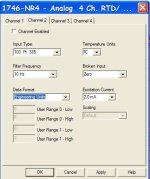I asked a question here several days ago pertaining to the same issue and I was asked to upload my program.
and you still haven't done that ... why not? ... trust me, I do NOT want to appear rude - but you're just not listening to us ...
I'll bet serious money that we've worked on MUCH LARGER programs here than the one that's giving you problems ...
ZIP IT and then POST IT! ... if you're not sure how to do that, then ask how and someone will tell you how ...
IMPORTANT! ... do NOT just post the single ladder file that you're having trouble with ... post the ENTIRE program (RSS) file ... that way we can tell how your I/O is set up, etc. - and we'll be able help you with DETAILED answers ...
quit fighting this ... you're making it a LOT harder on yourself than it needs to be ... we're willing to help you ... we're wanting to help you ... we're waiting to help you ... but we can't help you based on the descriptions that you've been giving us ... you need DETAILED help - but you keep asking GENERAL questions ...
case in point - based on your latest question ...
I:11.1 is PROBABLY the second channel of an analog input module located in Slot #11 of your chassis ... (we can't tell for SURE – since we don't know for SURE how your I/O is set up) ... the value stored in that location was 15620 ... the MOV instruction takes the value from the Source and writes that value into the Destination ... so after the MOV is executed, the location N140:42 (an integer-type location in the processor's data table) will also hold the value 15620 ... we can't tell what that value represents - since we don't know what type of I/O module you're using - or how it's set up - or how the signal is being scaled ...
now ... that's as far as we can go based on what you've just posted ... and what all of that has to do with controlling your heaters is just a GUESS from here on out UNLESS you post your program ...
ZIP IT and then POST IT! ...



